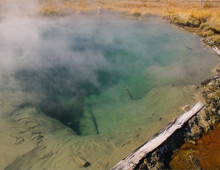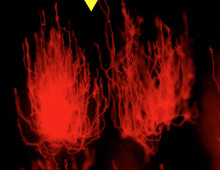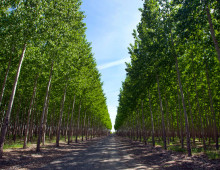“Nucleotid.es, a publicly available repository developed by a researcher at the Joint Genome Institute, aims to provide a comprehensive list of genome assemblers and associated benchmarks that will help researchers in the genomics community select and use the most appropriate assembly tools for their sequencing projects.” Full story on GenomeWeb. (Note: Free registration may be…
Elucidating Extremophilic “Microbial Dark Matter”
Metagenomics and single-cell genomics are providing the first substantial genomic data on uncultured microbes in extreme environments. The Science: Genomes from novel lineages of bacteria and archaea in extreme environments have become accessible through techniques such as metagenomics and single-cell genomics. The Impact: Applying single-cell genomics and metagenomics toward uncultivated microbes in extreme environments has…
Decoding Virus-Host Interactions in the Oxygen-Starved Ocean
For multicellular life—plants and animals—to thrive in the oceans, there must be enough dissolved oxygen in the water. In certain coastal areas, extreme oxygen-starvation produces “dead zones” that decimate marine fisheries and destroy food web structure. As dissolved oxygen levels decline, energy is increasingly diverted away from multicellular life into microbial community metabolism resulting in…
Far-Red Light Makes Far-Reaching Algal Changes
How a cyanobacterial strain adapts to boost photosynthesis efficiency under various light conditions. The Science: Researchers sequence the genome of a cyanobacterial strain isolated from hot springs near Yellowstone National Park and conduct gene expression and metabolic studies to understand how it adapts to utilize far-red light to photosynthesize. The Impact: Understanding how cyanobacteria utilize…
Comparing Genomes/Lifestyles of Freshwater Bacteria
Single-cell genomics sheds light on nutrient and carbon cycling in Actinobacteria. The Science: Researchers assembled and compared draft genomes of acI Actinobacteria from single cells collected in four freshwater lakes in the United States and Europe. The Impact: The single cells collected represented three different acI tribes of Actinobacteria, allowing researchers to learn more about…
Signatures of Selection Inscribed on Poplar Genomes
A Nature Genetics study describes a method that could be harnessed for developing more accurate predictive climate change models.
Understanding Aureobasidium’s Adaptability
Differences between genome sequences warrant fungal reclassifications. The Science: Researchers sequenced four samples of Aureobasidium fungi from various regions of the world to learn more about their potential biotechnological applications. The Impact: Comparative genomic analyses reveal genes that make the fungi capable of adapting to a wide range of environments and stresses, which can be…
How yeast formations got started
Comparative analyses reveal gene family conserved across multiple yeast lineages. The Science: Researchers conducted a comparative analysis of nearly 60 fungal genomes to determine the genetic traits that enabled the convergent evolution of yeasts. The Impact: The analyses suggest that a conserved zing-finger transcription factor family allowed yeasts to become the dominant form in multiple…
High quality reference Brassicales genomes
The Brassicaceae constitute not only one of the most diverse plant families, but also one rich in agronomically-important vegetable and oilseed crops. Several species have been domesticated and include different cabbages, broccoli, turnip, rapeseed, horseradish, and several mustards. Brassicaceae include a number of species that are current and emerging biodiesel crops. Researchers plan to generate…
Dark ocean microbial single cell genomics
Considered one of the largest biomes on Earth, the dark ocean is comprised of the water column below the epipelagic, including meso-, bathy- and abyssopelagic and the hadal zones. It contains an active and metabolically diverse microbial assemblage that is responsible for about half of marine organic carbon mineralization. A large-scale single cell genomics study…






